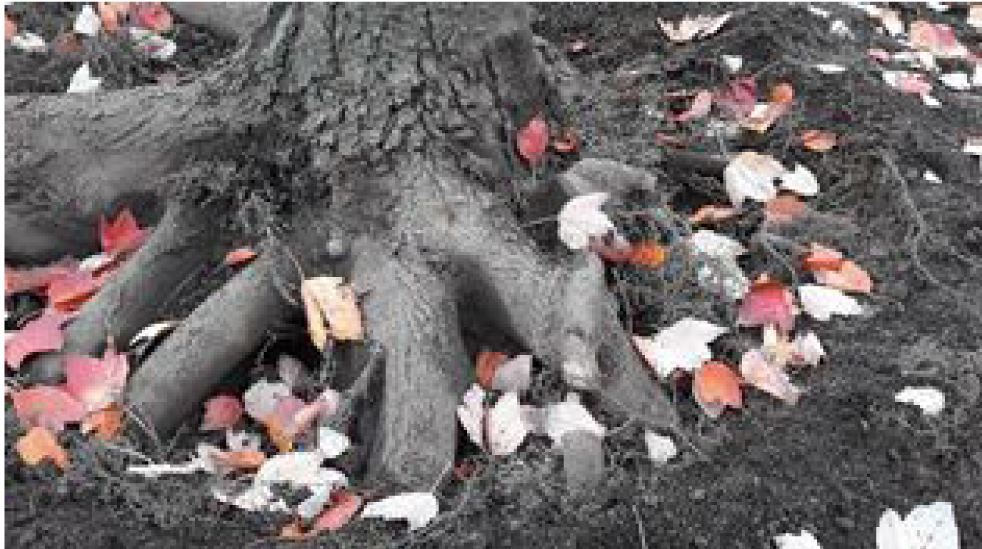The silent (preventable) tree killer – buried root flares and girdling roots

Trees are one of our most valuable assets. Trees give us shade in the summer, some produce fruits or nuts for us to eat, and they give off oxygen so that we can breathe. In our part of the country, it takes many more years for a tree to attain any real size due to a shorter growing season. That is why it is recommended to plant trees early in a phased landscape project, so they can begin establishing themselves as soon as possible. If you live in one place long enough, you can watch as the tree develops and changes the environment around it. When we plant a tree, we often plant it for the next generation to enjoy. Whatever the timing, it is never a bad time to add another tree (unless, of course, your property is overplanted).
Considering the money and time invested in growing a tree, it can be heart-breaking to lose a tree. In recent years we have had a number of pests that have found their way to our part of the country due to careless monitoring of items shipped in from other countries or from pests moving further north as the climate warms. Examples include the Emerald Ash Borer, the Hemlock Woolly Adelgid, and the Spotted Lanternfly. With all of these external forces to deal with, we should not include improper planting and maintenance to the list of things that cause tree decline. Unfortunately, the signs of this are seen almost everywhere you look.
When a seed drops to the ground and finds suitable soil in which to grow, upon germination, a seedling emerges. The sprout shoots upward towards the sun while the root radicle grows downward into the soil. This will develop into the plant’s roots system, an amazing part of the active, living biosphere underground. The area where the stem transitions to root is called the root flare. As the tree grows, this will become more visible. The roots will grow in a radial fashion, with branches heading out in all directions.
While most nursery people love trees and strive to grow plants properly, there are a couple of practices that, if not corrected upon planting in the landscape, can cause serious issues down the road. Container-grown trees can become root bound if not shifted up to a larger pot. In addition, when being planted in the container, the root flare might be planted below the potting mix if the planter is not on their toes. Field-grown trees might be planted too deeply when being lined out in the nursery field, especially if they are planted using a tractor-drawn bare-root planter. Over the years, as the trees remain in the field, soil can be kicked up on top of the root flare when the grower is cultivating for weed removal. When the trees are dug for sale, soil might be added to the root ball before the burlap is tightened up.
When these trees are planted in the landscape where it is hoped they will mature, the results of these issues may mean a sad end if not corrected upon planting. Before the tree is planted, it is of paramount importance to locate the root flare. In a container-grown plant, this may involve removing the tree from the pot and shaving down the potting mix until you find the root flare. At the same time, be sure to rough up the root ball to encourage lateral root growth. If the plant roots appear pot-bound, you may need to slice the roots in several top-to-bottom lines and then rough it up with your hands to free the roots from the circular pattern they have developed. With a field-grown tree, you will need to estimate where that root flare is and dig your tree hole, planning for the root flare to be several inches above grade. Once you place the tree in the planting hole, you will need to untie the burlap and begin your search for the root flare. These days, it is not unusual to take off the top three to four inches of soil from the root ball before you get to the proper planting level. If you dig your hole as deep as the root ball and place it in the hole, the root flare may wind up being below grade. Now you are stuck with having to pull the tree out of the hole, filling the hole with soil (and now you must be sure to add extra to allow for the soil to settle once the tree is in), and replace the tree in the hole. Remember, it is infinitely better to err on the side of planting a tad above grade than to plant below grade.
So, what issues arise from planting a tree too deeply or from the roots not growing radially? The main problem that occurs is the formation of girdling roots. The root flare separates the roots, which have evolved to be underground in a moist environment, from the stem and leaves, which have evolved to be above ground in a much drier environment. Stems that are below ground are confused and may send out roots as a response to this stress. These roots will grow over the top of the original root structure, and sometimes they will encircle the trunk. Some trees, like the maples, are prone to growing girdling roots even under perfect conditions. Like tree branches, as roots grow, they expand both in length and in girth. As the diameter of these roots expands, the roots will grow into each other. Eventually, these girdling roots will cut off the flow of water and nutrients from the soil to the rest of the plant, starving a portion of or the entire tree in the process. Since this takes time to occur, you may have many years invested in the tree before you begin to see the effects of the girdling root. Sometimes the tree can be saved, but sometimes the damage is too severe, requiring removal of the tree.
Besides improper planting, there is one other practice that can lead to girdling roots – improper application of mulch or the build-up of mulch over the years. Applying mulch so that it climbs up the trunk of the tree, commonly referred to as volcano-mulching, can definitely cause girdling roots to grow. It can also encourage diseases and insect infestations with all of that moist mulch placed against the stem. In addition, piling on several inches of mulch year after year can result in the root flare being buried. Mulch should never be placed up against a woody stem (shrub or tree). Automatically adding two to three inches of fresh mulch each year should be stopped. Sometimes, fluffing what is there and dusting some fresh mulch over the top is sufficient and will help prevent raising the grade.
Finally, it seems that it may be time to recommend root collar excavations as a preventive measure three to five years following installation in the landscape. Using an air spade to remove soil from around the trunk to look for girdling roots can save many trees and certainly seems a worthwhile expense to protect your investment. We love (and need) our trees. Let’s put in some effort to make sure they are healthy and thriving.
Information and photo from
Cornell Cooperative Extension Monroe County



